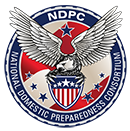
One lesson that many organizations learned during the COVID-19 pandemic is that we are living in an increasingly digital world. This year, the National Domestic Preparedness Consortium increased its efforts to reach students digitally. The NDPC unveiled its updated website design at the beginning of 2021, and in February, the NDPC launched its Twitter account (@NDPC_US) as a home base for students to connect with information and updates from all NDPC members.
NDPC member organizations who pivoted to online courses and resources are finding ways to incorporate these tools into their permanent training structures moving forward. When paired with their traditional infrastructure, these blended learning methods are proving efficient and effective for students.
SERTC
The Security and Emergency Response Training Center (SERTC) created SERTC Academy during the pandemic as a means of continuing vital training for responders. SERTC Academy courses pair web-based training sessions with hands-on residential training modules at the SERTC campus in Pueblo, Colorado. Web-based sessions at SERTC Academy allows first responders to start their training with less time away from home and work. Live streaming courses allow students to interact with SERTC instructors in a virtual classroom session, and review and complete recorded sessions.
This abbreviated in-person residential training blends the online learning and hands-on learning together. This Blended Learning model allows students to engage in live SERTC training regardless of their location.
“I liked the blended model that was provided for this course,” said one SERTC student. “Having the book work prior to getting here streamlined the process. As far as the hands-on portion, having all the training props available was very helpful. You can go around and get training on this or that but having it all here was awesome.”
TEEX/NERRTC
During the pandemic, Texas A&M’s Engineering Extension Service’s National Emergency Response and Recovery Training Center (TEEX/NERRTC) modified 21 face-to-face courses into a virtual format and were able to train more than 6,700 participants over 335 deliveries. Those courses capable of being delivered virtually will remain as a secondary option to those jurisdictions who are limited by COVID-19 case numbers, and where conducting in-person training is not feasible or safe to conduct to local participants.
TEEX/NERRTC has also began the process of implementing paperless student registrations and providing students with the ability to take pre and post tests electronically. In the coming year, TEEX/NERRTC will also have the ability to provide students an electronic copy of student handbooks and other material previously only available in a paper form. This transition will not only serve as cost-effective change, but will also be an added convenience to participants.

NDPTC
The University of Hawaii’s National Disaster Preparedness Training Center (NDPTC) has collaborated with several states to build out their training calendars with a combination of face-to-face and virtual deliveries to ensure equitable access to training for those that would not normally be able to participate in face-to-face training.
Hosts from different corners of a state are now able to "share" a delivery to encourage regional collaboration and information sharing. Many participants note that they appreciate hearing from other participants from different areas to get new ideas and approaches to similar issues and network for future collaboration and potential EMAC opportunities.
They are also utilizing web tools to foster engagement and collaboration within the course delivery going forward, such as recreating activity sheets in Google Docs so participants can work together in real time.

LSU NCBRT/ACE
Louisiana State University’s National Center for Biomedical Research and Training/Academy of Counter-Terrorist Education (LSU NCBRT/ACE) created a national open enrollment training schedule and has converted a number of its DHS-certified courses to a Zoom format. Because of this increased flexibility, LSU NCBRT/ACE has been able to reach a much larger audience, including more rural areas and individua agencies that may lack the resources to host mobile training. LSU NCBRT/ACE is also able to provide closed captioning for any Zoom course upon request.
In addition to virtual courses, almost all manuals and other paper documents for direct delivery courses are now virtual. Multiple documents are used in a link for students to download and follow along in class. LSU NCBRT/ACE has also continued producing webinars, micro modules, and online DHS-certified training courses on a variety of topics. In order to reach a wide variety of responders, the majority of the webinars on the e-Learning site are available in Spanish.
LSU NCBRT/ACE launched its Tribal Public Safety Dialogue Sessions, which brings together members from tribes across the country to engage on various topics once a month. Over 450 tribal responders, public health
professionals, and community leaders have participated in the sessions since they began in April.
“It was amazing to have Native Instructors from Indian Country to facilitate such an important and necessary training,” said Towatoy Bourgeau, Director of Security for the Nez Perce Clearwater River Casino and Lounge. “The instructors were top notch and the training material was invaluable.”
Finally, the LSU NCBRT Preparedness Podcast has continued to facilitate thoughtful, timely, and useful conversations within the responder community in 2021. This year, LSU NCBRT/ACE published 25 podcast episodes on topics including women in law enforcement, tribal emergency management, food and agriculture safety, and generational issues in law enforcement.
NMT/EMRTC
New Mexico Tech’s Energetic Materials Research and Testing Center (NMT/EMRTC) has adopted online resources such as providing QR codes to participants to access registration forms, travel forms, and course materials on their own devices. They have also started offering hybrid deliveries, where instructors provide direct delivery instruction while the host has their own IT and moderator to facilitate the virtual session for students who are unable to attend courses in person.
For its instructors, NMT/EMRTC conducts a virtual onboarding process for online teaching, where instructors are introduced to some of the features used during virtual trainings and discuss the roles of staff and instructors. They also deliver kits to instructors that contain containing a tablet, charger, mouse, and other resources. Some instructors don’t have a stable internet or a computer with audio and/or video capabilities. The kits provide instructors with stable, reliable internet access, audio and video capabilities, as well as give NMT/EMRTC staff a uniform way of troubleshooting and coordinating devices.

CDP
The Center for Domestic Preparedness (CDP) completed development and implementation of two new online courses and 31 new Virtual Instructor-Led Training (VILT) topics in FY2021. That brought the total number of CDP online and virtual offerings to 81.
The VILT deliveries have been a particularly popular addition to the types of training options offered by the CDP. The VILTs are scheduled for online student registration, delivered virtually via web-conferencing, and provide a convenient means for responders to participate in training. The CDP recognizes that web-based training supports but is not a replacement for the in-person, hands-on training it offers.
In FY2021, the CDP amassed a total of 21,545 VILT completions. The CDP also completed establishment of a YouTube Training Channel for the delivery of audio- and video-based micro-learning in FY2021. It also posted its first micro-learning video, about fentanyl awareness, to the platform and started work on its second micro-learning video, about the preparation of containers and pumps for the safe transfer of hazardous liquids.
Going forward, the CDP intends to add four to five micro-learning offerings a year to the channel on topics relevant to responders.
The future of emergency preparedness will no doubt involve connecting responders through digital tools. The NDPC and its members are prepared to meet the needs of state, local, tribal, and territorial responders through a variety of resources, and increasing digital course deliveries and resources will ensure that the highest quality training is available to as many students as possible.



